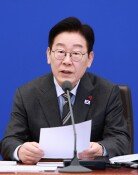Can North Korea Supply 100,000 Workers?
Can North Korea Supply 100,000 Workers?
Posted December. 22, 2005 03:02,
December 15 marked the one-year anniversary of the Gaesong Industrial Complex, the symbol of inter-Korean economic cooperation.
Unification Minister Chung Dong-young, who is visiting the U.S., met with U.S. Secretary of State Condoleezza Rice on December 20 and said, Next years core business will be the development of the main section of the Gaesong Industrial Complex. Chung also asked Deputy Secretary of Commerce David Sampson for a U.S. corporate presence in the industrial complex.
This article deals with the potential and the problems of the Gaesong Industrial Complex, and will evaluate whether the combination of South Koreas technology and capital and the Norths manpower will be able to open a new era in which the two Koreas can prosper together.
You cant sit on the production line like that, said a South Korean technology supervisor. Sorry. Im not accustomed to this, responded a North Korean worker.
The training room of A company in the pilot complex in the Gaesong industrial park has recently been filled with non-skilled North Korean workers receiving technology training. As only 10 percent of workers from the North have work experience in this field, the company is spending a lot of time and resources in giving technology training to the remaining workforce.
The biggest strength of the Gaesong Industrial Complex is cheap labor. An average North Korean worker receives $57.50 (approximately 58,000 won) in monthly wages. But the problem is the quality of the labor. North Korean workers still lack technological skills.
A total of 11 companies are operating in the 28,000-pyeong pilot complex. Four other companies are preparing for operation or building plants.
The South Korean government is planning to develop a one-million-pyeong main complex by late next year to attract 300 companies, but it is still uncertain whether the North could provide sufficient quality labor. Also, nobody knows how long labor costs would remain low.
Labor Quality Issue-
Companies in the pilot complex want workers aged 35 or younger with endurance and relatively good ability to acquire skills.
An executive of B company said, Although we requested the North to fill the factory workforce with young workers in their 20s and 30s, people in their 40s and 50s account for more than half of the workforce. The president of C company said, If one sets the level of a South Korean worker at 100, that of a North Korean worker currently stands at 60 to 70.
Nonetheless, companies in the industrial complex and the government generally assess that the Norths workers are acquiring skills more quickly than expected. The government decided to open a job training center in the industrial complex by 2007 to offer North Korean workers well-organized technology training.
An official at D company said, It is worth trying if we can improve North Korean workers skills and eliminate waste resulted from a slowed supply of raw materials and exports by streamlining traffic and the customs clearance process.
Labor Quantity Problem-
There is prevailing concern that the North would lack the absolute amount of labor force if companies begin to enter the main complex in full swing. The unification minister expects that 70,000 to 100,000 North Korean workers are needed to operate 300 companies in the main complex.
The unification minister said last month in a lecture on the invitation of Korea-based diplomats, About 1,000 companies will do business in the Gaesong Industrial Complex within three years, and the workforce which currently stands at some 6,000 will grow to 300,000 to 400,000 in three or four years.
Dong Myeong-han, a director of inter-Korean cooperation at Small Business Corporation, said, Although only 11 companies are operating in the pilot complex, manpower around Gaesong area is already stretched thin, and further pointed out, The problem is where we can get tens of thousands of workers that will be needed in the future.
In response, Pyongyang is just repeating that it would input military or militia organization without unveiling a concrete plan.
Seoul does not have a clear alternative either. An official said, Technically, the North should resolve the manpower problem, but it is hard to know where and how it would provide it.
A Wage Problem-
The regulation of labor in the Gaesong Industrial Complex states that wages for employees shall not be raised by more than five percent of the previous years minimum wage, with the minimum wage being $50 a month. In this sense, there is no need to worry about soaring wages.
However, an official at E company predicted, If employees stage a strike demanding a raise and the North authorities promote or support it when hundreds of companies are operating in the complex, companies would not be able to sustain their business there.
For sure, there is also an opposing view which says that North Korean authorities will not allow soaring wages because they are developing the entire North Korea into an industrial park modeled after the Gaesong Industrial Complex.
There is a mixed view of cautious optimism and realistic concerns about the future of the Gaesong Industrial Complex. Optimism is mostly based on the willingness and necessity of South and North Korean authorities to make the industrial complex a success.
The issue is to prevent non-economic variables, such as the North Korean nuclear problem, from hindering advancement of the industrial complex, and to secure better profitability than other production bases with cheap labor, including China and Vietnam.
Myoung-Gun Lee gun43@donga.com





![“한동훈, 정치생명 걸고 무소속 출마해 평가받는 것 고려할만”[정치를 부탁해]](https://dimg.donga.com/c/138/175/90/1/wps/NEWS/IMAGE/2026/01/19/133186982.1.jpg)

